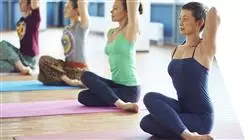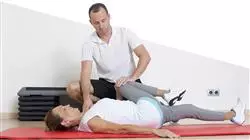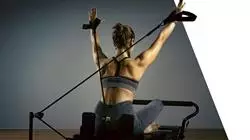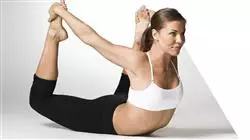University certificate
Scientific endorser

The world's largest faculty of sports science”
Why study at TECH?
A 100% online university program that will bring you up to date on the therapeutic applications of Pilates to prevent and rehabilitate injuries related to professional physical activity"

Strengthening, stabilizing muscles, and developing greater flexibility are crucial for athletes in different sports. Achieving both is a challenge for coaches and physical trainers who seek to offer competitors the ideal strategies to increase their strength, balance, coordination, and endurance and optimize their performance. In this sense, the Pilates method has become an attractive solution for professionals in this field. However, achieving a high level of training in the correct handling of exercises and work tools can be challenging for some people.
For this reason, TECH has put together this program that delves into the therapeutic potential of this discipline. Its exhaustive syllabus will examine how Pilates techniques can help prevent injuries in athletes and, at the same time, contribute to the rehabilitation of parts of the locomotor system that are already affected. Specifically, they will address the most frequent alterations in the Spine, Upper and Lower Limbs that can be treated by means of powerful instruments such as the Spine Corrector, the Bosu, among others.
In addition, among the 10 modules of the degree, students will be able to analyze specific topics on the advantages and contraindications of Pilates in relation to specific sports such as Swimming, Athletics, and racquet competitions. They will also learn how players of Soccer, Basketball, Rugby, Golf, among others, can achieve a better state of health and well-being through this method.
This Professional master’s degree has a 100% online methodology, where Relearning is key for graduates to master the most complex concepts in a fast, flexible, and rigorous way. They will also be supported by the study of real cases and simulated situations to develop competencies that will allow them to practice with precision immediately after completing the program. Likewise, all the contents and multimedia resources that are integrated into the degree have been selected by an exceptional teaching staff composed of experts with extensive experience in the application of the Pilates method to sports practice.
You will master innovative tools of Therapeutic Pilates such as the Spine Correctos or the Buso, integrating them with excellence in your daily professional practice"
This Professional master’s degree in Therapeutic Pilates contains the most complete and updated scientific program on the market. Its most outstanding features are:
- The development of practical cases presented by experts in Physiotherapy and Pilates
- The graphic, schematic, and practical contents with which they are created, provide scientific and practical information on the disciplines that are essential for professional practice
- Practical exercises where self-assessment can be used to improve learning
- Its special emphasis on innovative methodologies
- Theoretical lessons, questions to the expert, debate forums on controversial topics, and individual reflection assignments
- Content that is accessible from any fixed or portable device with an Internet connection
You will delve into the most frequent alterations in the Spine, Upper, and Lower Limbs suffered by athletes and how to solve them through the most innovative exercises of the Pilates method"
The program’s teaching staff includes professionals from the sector who contribute their work experience to this educational program, as well as renowned specialists from leading societies and prestigious universities.
Its multimedia content, developed with the latest educational technology, will provide the professional with situated and contextual learning, i.e., a simulated environment that will provide an immersive education programmed to learn in real situations.
The design of this program focuses on Problem-Based Learning, by means of which the professional must try to solve the different professional practice situations that are presented throughout the academic course. For this purpose, the student will be assisted by an innovative interactive video system created by renowned experts.
With the best multimedia resources, such as infographics and interactive summaries, this program will guarantee you diverse skills to perform in the field of Therapeutic Pilates"

Through this intensive course, you will develop a holistic view of the therapeutic potential of Pilates to boost the performance and well-being of competitors"
Syllabus

This Professional master’s degree does not have hermetic schedules, therefore guaranteeing you free access to its contents 24 hours a day"
Module 1. The Pilates Method
1.1. Joseph Pilates
1.1.1. Joseph Pilates
1.1.2. Books and postulates
1.1.3. Legacy
1.1.4. Origin of customized exercise
1.2. Background of the Pilates Method
1.2.1. References
1.2.2. Evolution
1.2.3. Current Situation
1.2.4. Conclusions
1.3. Method Evolution
1.3.1. Improvements and modifications
1.3.2. Contributions to the Pilates method
1.3.3. Therapeutic Pilates
1.3.4. Pilates and Physical Activity
1.4. Principles Pilates Method
1.4.1. Definition of Principles
1.4.2. Evolution of Principles
1.4.3. Progression levels
1.4.4. Conclusions
1.5. Classical versus Contemporary/Modern Pilates
1.5.1. Key points in Classical Pilates
1.5.2. Modern/Classical Pilates Analysis
1.5.3. Contributions of Modern Pilates
1.5.4. Conclusions
1.6. Pilates on the Floor and Pilates on Machines
1.6.1. Fundamentals of Floor Pilates
1.6.2. Evolution of Pilates on floor
1.6.3. Fundamentals of Pilates on Machines
1.6.4. Evolution of Pilates on Machines
1.7. Scientific Evidence
1.7.1. Scientific journals related to Pilates
1.7.2. Doctoral thesis on Pilates
1.7.3. Pilates Publications
1.7.4. Pilates applications
1.8. Orientations of the Pilates Method
1.8.1. National trends
1.8.2. International trends
1.8.3. Trend Analysis
1.8.4. Conclusions
1.9. Schools
1.9.1. Pilates Training Schools
1.9.2. Magazines
1.9.3. Evolution of pilates schools
1.9.4. Conclusions
1.10. Pilates Associations and Federations
1.10.1. Definitions
1.10.2. Benefits
1.10.3. Objectives
1.10.4. PMA
Module 2. Fundamentals of the Pilates Method
2.1. The different concepts of the method
2.1.1. The concepts according to Joseph Pilates
2.1.2. Evolution of Concepts
2.1.3. Subsequent generations
2.1.4. Conclusions
2.2. Breathing
2.2.1. The different types of breathing
2.2.2. Analysis of types of breathing
2.2.3. The Effects of breathing
2.2.4. Conclusions
2.3. Pelvis as the core of stability and movement
2.3.1. The Joseph Pilates Core
2.3.2. The Scientific Core
2.3.3. Anatomical basis
2.3.4. Core in recovery processes
2.4. The organization of the shoulder girdle
2.4.1. Anatomical Review
2.4.2. Shoulder Girdle Biomechanics
2.4.3. Pilates applications
2.4.4. Conclusions
2.5. The organization of lower limb movement
2.5.1. Anatomical Review
2.5.2. Biomechanics of the Lower Limb
2.5.3. Pilates applications
2.5.4. Conclusions
2.6. The articulation of the spine
2.6.1. Anatomical Review
2.6.2. Biomechanics of the Spine
2.6.3. Pilates applications
2.6.4. Conclusions
2.7. Body segment alignments
2.7.1. Posture
2.7.2. Posture in Pilates
2.7.3. Segmental alignments
2.7.4. Muscle and fascial chains
2.8. Functional integration
2.8.1. Concept of functional Integration
2.8.2. Implications on different activities
2.8.3. The task
2.8.4. The Context
2.9. Fundamentals of Therapeutic Pilates
2.9.1. History of Therapeutic Pilates
2.9.2. Concepts in Therapeutic Pilates
2.9.3. Criteria in Therapeutic Pilates
2.9.4. Examples of injuries or pathologies
2.10. Pilates clásico y Pilates terapéutico
2.10.1. Differences between both methods
2.10.2. Justification
2.10.3. Progressions
2.10.4. Conclusions
Module 3. The Pilates gym
3.1. The Reformer
3.1.1. Introduction to the Reformer
3.1.2. Reformer Benefits
3.1.3. Main exercises on the Reformer
3.1.4. Main errors on the Reformer
3.2. The Cadillac or Trapeze table
3.2.1. Introduction to Cadillac
3.2.2. Cadillac Benefits
3.2.3. Main exercises on the Cadillac
3.2.4. Main errors on the Cadillac
3.3. The chair
3.3.1. Introduction to the chair
3.3.2. Chair benefits
3.3.3. Main exercises on the chair
3.3.4. Main Errors on the chair
3.4. The Barrel
3.4.1. Introduction to the Barrel
3.4.2. Barrel Benefits
3.4.3. Main exercises on the Barrel
3.4.4. Main errors on the Barrel
3.5. "Combo" models
3.5.1. Introduction to the Combo model
3.5.2. Combo model benefits
3.5.3. Main exercises on the Combo model
3.5.4. main errors in the Combo model
3.6. The flexible ring
3.6.1. Introduction to flexible ring
3.6.2. Flexible ring benefits
3.6.3. Main exercises on the flexible ring
3.6.4. Main Errors on the flexible ring
3.7. The Spine Corrector
3.7.1. Introduction to Spine corrector
3.7.2. Spine corrector benefits
3.7.3. Main exercises on the Spine corrector
3.7.4. Main Errors on the Spine corrector
3.8. Implements adapted to the method
3.8.1. Foam roller
3.8.2. Fit Ball
3.8.4. Elastic bands
3.8.5. Bosu
3.9. The Space
3.9.1. Equipment preferences
3.9.2. The Pilates space
3.9.3. Pilates instruments
3.9.4. Best practices in terms of space
3.10. The Environment
3.10.1. Environment concept
3.10.2. Characteristics of different environments
3.10.3. Environment choice
3.10.4. Conclusions
Module 4. Methodology in the practice of the Pilates Method
4.1. The initial session
4.1.1. Initial Assessment
4.1.2. Informed Consent
4.1.3. Words and commands related to Pilates
4.1.4. Onset on the Pilates Method
4.2. Initial Assessment
4.2.1. Postural assessment
4.2.2. Flexibility assessment
4.2.3. Evaluación coordinativa
4.2.4. Session planning. Pilates card
4.3. Pilates class
4.3.1. Initial exercises
4.3.2. Student groupings
4.3.3. Positioning, voice, corrections
4.3.4. Resting
4.4. Student-patients
4.4.1. Pilates student typology
4.4.2. Personalized commitment
4.4.3. Student objectives
4.4.4. The choice of method
4.5. Exercise progressions and regressions
4.5.1. Introduction to progressions and regressions
4.5.2. Progressions
4.5.3. Regressions
4.5.4. The evolution of treatment
4.6. General protocol
4.6.1. A basic generalized protocol
4.6.2. Respect Pilates fundamentals
4.6.3. Protocol analysis
4.6.4. Protocol functions
4.7. Indications of the exercises
4.7.1. Characteristics of initial position
4.7.2. Contraindications of the exercises
4.7.3. Verbal, tactile aids
4.7.4. Class scheduling
4.8. The teacher/monitor
4.8.1. Student analysis
4.8.2. Types of teachers
4.8.3. Generation of an adequate environment
4.8.4. Student follow-up
4.9. The basic program
4.9.1. Pilates for beginners
4.9.2. Pilates for intermediates
4.9.3. Pilates for experts
4.9.4. Professional Pilates
4.10. Software for pilates studio
4.10.1. Main pilates studio software
4.10.2. Application for pilates practicing
4.10.3. Latest technology in the pilates studio
4.10.4. Most significant advances in Pilates studio
Module 5. Pilates in Spine disorders
5.1. Basic anatomical recall
5.1.1. Osteology of the Spine
5.1.2. Spinal myology
5.1.3. Biomechanics of the Spine
5.1.4. Conclusions
5.2. Frequent pathologies susceptible to treatment with Pilates
5.2.1. Growth pathologies
5.2.2. Pathologies in elderly patients
5.2.3. Pathologies in the sedentary person
5.2.4. Pathologies in the athlete
5.3. Exercises indicated in MATT, on Machines, and with Implements. General protocol
5.3.1. Stretching exercises
5.3.2. Core stabilization exercises
5.3.3. Joint mobilization exercises
5.3.4. Strengthening exercises
5.3.5. Functional exercises
5.4. Disk Pathology
5.4.1. Patho-mechanics
5.4.2. Disc syndromes
5.4.3. Differences between types of pathologies
5.4.4. Good Practices
5.5. Articular Pathology
5.5.1. Patho-mechanics
5.5.2. Joint syndromes
5.5.3. types of pathologies
5.5.4. Conclusions
5.6. Muscular Pathology
5.6.1. Patho-mechanics
5.6.2. Muscle syndromes
5.6.3. Types of pathologies
5.6.4. Conclusions
5.7. Cervical spine pathology
5.7.1. Symptoms
5.7.2. Cervical syndromes
5.7.3. Specific protocols
5.7.4. Conclusions
5.8. Dorsal Spine Pathology
5.8.1. Symptoms
5.8.2. Dorsal syndromes
5.8.3. Specific protocols
5.8.4. Conclusions
5.9. Lumbar Spine Pathology
5.9.1. Symptoms
5.9.2. Lumbar syndromes
5.9.3. Specific protocols
5.9.4. Conclusions
5.10. Sacroiliac Pathology
5.10.1. Symptoms
5.10.2. Lumbar syndromes
5.10.3. Specific protocols
5.10.4. Conclusions
Module 6. Pilates in Upper Limb disorders
6.1. Basic anatomical recall
6.1.1. Osteology of the Upper Limb
6.1.2. Myology of the Upper Limb
6.1.3. Biomechanics of the Upper Limb
6.1.4. Good Practices
6.2. Stabilization exercises
6.2.1. Introduction to stabilization exercise
6.2.2. MATT stabilization exercises
6.2.3. Machine stabilization exercises
6.2.4. Best stabilization exercises
6.3. Joint mobilization exercises
6.3.1. Introduction to joint mobility exercises
6.3.2. Joint mobility exercises MATT
6.3.3. Joint mobility exercises on machine
6.3.4. Best joint mobility exercises
6.4. Strengthening exercises
6.4.1. Introduction to strengthen exercises
6.4.2. MATT strengthen exercises
6.4.3. Machine strengthen exercises
6.4.4. Best strengthen exercises
6.5. Functional exercises
6.5.1. Introduction to functional exercises
6.5.2. MATT functional exercises
6.5.3. Machine stabilization exercises
6.5.4. Best functional exercises
6.6. Shoulder Pathology Specific protocols
6.6.1. Painful Shoulder
6.6.2. Frozen shoulder
6.6.3. Shoulder hypomobility
6.6.4. Shoulder exercises
6.7. Elbow pathology Specific protocols
6.7.1. Articular Pathology
6.7.2. Muscle--tendon Pathology
6.7.3. Post-traumatic or post-surgical elbow
6.7.4. Elbow Exercises
6.8. Wrist Pathology
6.8.1. Main syndromes
6.8.2. Wrist pathology types
6.8.3. Wrist Exercises
6.8.4. Conclusions
6.9. Pathology of the Hand
6.9.1. Main syndromes
6.9.2. Hand pathology types
6.9.3. Hand Exercises
6.9.4. Conclusions
6.10. Nerve entrapments in the upper limb
6.10.1. Brachial Plexus
6.10.2. Peripheral Nerves
6.10.3. Types of pathologies
6.10.4. Exercises for nerve entrapments in the Upper Limb
Module 7. Pilates in Lower Limb disorders
7.1. Basic anatomical recall
7.1.1. Osteology of the Lower Limb
7.1.2. Myology of the Lower Limb
7.1.3. Biomechanics of the Lower Limb
7.1.4. Good Practices
7.2. Frequent pathologies susceptible to treatment with Pilates
7.2.1. Growth pathologies
7.2.2. Pathologies in the athlete
7.7.3. Other Types of Pathologies
7.7.4. Conclusions
7.3. Exercises indicated on Mat, Machines, and Implements. General protocol
7.3.1. Dissociation exercises
7.3.2. Mobilization exercises
7.3.3. Strengthening exercises
7.3.4. Functional exercises
7.4. Hip Pathology
7.4.1. Articular Pathology
7.4.2. Muscle-tendon Pathology
7.4.3. Surgical pathology. Prosthesis
7.4.4. Hip Exercises
7.5. Knee Pathology
7.5.1. Articular Pathology
7.5.2. Muscle-tendon Pathology
7.5.3. Surgical pathology. Prosthesis
7.5.4. Knee Exercises
7.6. Ankle Pathology
7.6.1. Articular Pathology
7.6.2. Muscle-tendon Pathology
7.6.3. Surgical pathology
7.6.4. Ankle Exercises
7.7. Foot Pathology
7.7.1. Joint and fascial pathology
7.7.2. Muscle-tendon Pathology
7.7.3. Surgical pathology
7.7.4. Foot Exercises
7.8. Nerve entrapments in the Lower limb
7.8.1. Brachial Plexus
7.8.2. Peripheral Nerves
7.8.3. Types of pathologies
7.8.4. Exercises for nerve entrapments in the Lower Limb
7.9. Analysis of the anterolateral chain of the lower limb.
7.9.1. What is the anterolateral chain, and how important is it for the patient?
7.9.2. Important aspects for assessment
7.9.3. The relationship of the chain with pathology already described
7.9.4. Exercises for training of the anterolateral chain
7.10. Analysis of the posterior-medial chain of the lower limb.
7.10.1. What is the posterior-medial chain, and how important is it for the patient?
7.10.2. Important aspects for assessment
7.10.3. The relationship of the complex with pathology already described
7.10.4. Exercises for posterior-medial chain
Module 8. General pathology and its treatment with Pilates
8.1. Nervous system
8.1.1. Central Nervous System
8.1.2. Peripheral Nervous System
8.1.3. Brief description of neural pathways
8.1.4. Benefits of Pilates in neurological pathology
8.2. Neurological assessment focused on Pilates
8.2.1. Medical History
8.2.2. Strength and tone assessment
8.2.3. Sensitivity assessment
8.2.4. Tests and scales
8.3. Most prevalent neurological pathologies and scientific evidence in Pilates
8.3.1. Brief description of the pathologies
8.3.2. Basic principles of Pilates in neurological pathology
8.3.3. Adaptation of Pilates positions
8.3.4. Adaptation of Pilates Exercises
8.4. Multiple Sclerosis
8.4.1. Pathology description
8.4.2. Assessment of the patient's capabilities
8.4.3. Adaptation of Pilates exercises on floor
8.4.4. Adaptation of Pilates exercises with elements
8.5. Stroke
8.5.1. Pathology description
8.5.2. Assessment of the patient's capabilities
8.5.3. Adaptation of Pilates exercises on floor
8.5.4. Adaptation of Pilates exercises with elements
8.6. Parkinson’s Disease
8.6.1. Pathology description
8.6.2. Assessment of the patient's capabilities
8.6.3. Adaptation of Pilates exercises on floor
8.6.4. Adaptation of Pilates exercises with elements
8.7. Cerebral Palsy
8.7.1. Pathology description
8.7.2. Assessment of the patient's capabilities
8.7.3. Adaptation of Pilates exercises on floor
8.7.4. Adaptation of Pilates exercises with elements
8.8. Older adults
8.8.1. Age-related pathologies
8.8.2. Assessment of the patient's capabilities
8.8.3. Indicated exercises
8.8.4. Contraindicated exercises
8.9. Osteoporosis
8.9.1. Pathology description
8.9.2. Assessment of the patient's capabilities
8.9.3. Indicated exercises
8.9.4. Contraindicated exercises
8.10. Pelvic Floor Disorders: urinary incontinence
8.10.1. Pathology description
8.10.2. Incidence and Prevalence
8.10.3. Indicated exercises
8.10.4. Contraindicated exercises
Module 9. Pilates during Pregnancy, Childbirth, and Postpartum
9.1. First Trimester
9.1.1. Changes in the first quarter
9.1.2. Benefits and objectives
9.1.3. Indicated exercises
9.1.4. Contraindications
9.2. Second quarter
9.2.1. Changes in the Second quarter
9.2.2. Benefits and objectives
9.2.3. Indicated exercises
9.2.4. Contraindications
9.3. Third Trimester
9.3.1. Changes in the third quarter
9.3.2. Benefits and objectives
9.3.3. Indicated exercises
9.3.4. Contraindications
9.4. Birth
9.4.1. Dilation and delivery phase
9.4.2. Benefits and objectives
9.4.3. Recommendations
9.4.4. Contraindications
9.5. Immediate Postpartum
9.5.1. Recovery and puerperium
9.5.2. Benefits and objectives
9.5.3. Indicated exercises
9.5.4. Contraindications
9.6. Urinary Incontinence and Pelvic Floor
9.6.1. Anatomy involved
9.6.2. Pathophysiology
9.6.3. Indicated exercises
9.6.4. Contraindications
9.7. Problems in pregnancy and approach through the Pilates Method
9.7.1. Body statics change
9.7.2. Most Frequent Problems
9.7.3. Indicated exercises
9.7.4. Contraindications
9.8. Pregnancy preparation
9.8.1. Benefits of physical training during pregnancy
9.8.2. Recommended physical activity
9.8.3. Indicated exercises for the first pregnancy
9.8.4. Preparation during the search for the second and subsequent
9.9. Late Postpartum
9.9.1. Long-term anatomical changes
9.9.2. Preparation for the return to physical activity
9.9.3. Indicated exercises
9.9.4. Contraindications
9.10. Post-partum alterations
9.10.1. Abdominal diastasis
9.10.2. Static pelvic-prolapse shift
9.10.3. Alterations of deep abdominal musculature
9.10.4. Indications and contraindications in cesarean section
Module 10. Pilates in sports
10.1. Soccer
10.1.1. Most Common Injuries
10.1.2. Pilates as treatment and prevention
10.1.3. Benefits and objectives
10.1.4. Example in elite athletes
10.2. Racquet Sports
10.2.1. Most Common Injuries
10.2.2. Pilates as treatment and prevention
10.2.3. Benefits and objectives
10.2.4. Example in elite athletes
10.3. Basketball
10.3.1. Most Common Injuries
10.3.2. Pilates as treatment and prevention
10.3.3. Benefits and objectives
10.3.4. Example in elite athletes
10.4. Handball
10.4.1. Most Common Injuries
10.4.2. Pilates as treatment and prevention
10.4.3. Benefits and objectives
10.4.4. Example in elite athletes
10.5. Golf
10.5.1. Most Common Injuries
10.5.2. Pilates as treatment and prevention
10.5.3. Benefits and objectives
10.5.4. Example in elite athletes
10.6. Swimming
10.6.1. Most Common Injuries
10.6.2. Pilates as treatment and prevention
10.6.3. Benefits and objectives
10.6.4. Example in elite athletes
10.7. Athletics
10.7.1. Most Common Injuries
10.7.2. Pilates as treatment and prevention
10.7.3. Benefits and objectives
10.7.4. Example in elite athletes
10.8. Dance and performing arts
10.8.1. Most Common Injuries
10.8.2. Pilates as treatment and prevention
10.8.3. Benefits and objectives
10.8.4. Example in elite athletes
10.9. Roller Hockey
10.9.1. Most Common Injuries
10.9.2. Pilates as treatment and prevention
10.9.3. Benefits and objectives
10.9.4. Example in elite athletes
10.10. Rugby
10.10.1. Most Common Injuries
10.10.2. Pilates as treatment and prevention
10.10.3. Benefits and objectives
10.10.4. Example in elite athletes

An academic itinerary of 1,500 hours that guarantees thorough handling of the most advanced techniques of the Therapeutic Pillars. Don't wait any longer and enroll today"
Professional Master's Degree in Therapeutic Pilates
Discover at TECH's prestigious Faculty of Sport Sciences an exceptional opportunity to enhance your knowledge with the Professional Master's Degree in Therapeutic Pilates, an online modality Postgraduate Certificate that will immerse you in the deep world of rehabilitation and physical wellness. Are you ready to challenge your limits and open yourself to new perspectives? Immerse yourself in a program meticulously designed by a team of highly trained and experienced faculty. Their commitment to academic excellence ensures that you get the highest quality instruction. From the comfort of your own environment, you will acquire technical and theoretical skills that will enable you to tackle complex rehabilitation cases and improve the quality of life of your future patients. During the Professional Master's Degree, you will explore the anatomical and biomechanical fundamentals behind the Pilates method, applying them to real clinical situations. You will learn how to adapt exercises to address specific injuries and promote functional recovery. In addition, the program will cover the mind-body interaction in depth, providing you with the tools to guide your patients toward a holistic recovery.
Expand your knowledge in therapeutic pilates
This unique study opportunity at TECH gives you the flexibility to advance at your own pace and balance your existing commitments. Upon successful completion of the program, you'll earn a certificate that validates your skills and knowledge in Therapeutic Pilates, broadening your job prospects and differentiating yourself in the competitive field of rehabilitation and fitness. Imagine being able to work closely with healthcare professionals, physical therapists and personal trainers to provide holistic solutions to those seeking recovery and wellness. With TECH's Professional Master's Degree in Therapeutic Pilates, you will become a specialist capable of making a significant difference in the lives of others. Don't miss the opportunity to be part of this educational and transformative journey at TECH Global University. Your future in rehabilitation is just a click away.







